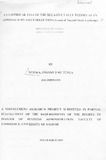| dc.contributor.author | Nzioka, Onesmus M | |
| dc.date.accessioned | 2013-05-11T12:03:01Z | |
| dc.date.available | 2013-05-11T12:03:01Z | |
| dc.date.issued | 2002 | |
| dc.identifier.citation | A Management Research Project Report Submitted in Partial Fulfillment for the Requirements of the Degree of Masters of Business Administration (MBA), School Of Business, University Of Nairobi | en |
| dc.identifier.uri | http://erepository.uonbi.ac.ke:8080/xmlui/handle/123456789/22069 | |
| dc.description.abstract | The study set out to investigate whether Investment strategy in choosing assets to include in a
portfolio using geometric mean is significantly different from the one used in choosing assets to
include in a portfolio using arithmetic mean if the target return is the same.
The need for the study emanated from the apparent competition between maximization of
arithmetic mean of returns and maximization of geometric mean of returns. Such a competition
would leave the problem of correctly choosing assets by investors unresolved and therefore very
necessary to determine which of the two techniques above is better as far as maximizing returns
in the long run is concerned.
Shares' historical returns were computed and both their yearly arithmetic mean and geometric
mean determined using secondary data obtained from the companies' financial statements
available at the Nairobi Stock Exchange. Portfolios were constructed and two efficient frontiers
designed; one on the basis of the arithmetic mean and the other on the basis of the geometric
mean.
The findings were that, firstly, the arithmetic mean return and geometric mean return are not
statistically significantly different. This finding is strongly supported by the argument that there
is an insignificant difference in the respective proportion of weights in the shares constituting the
portfolios in both the geometric mean and arithmetic mean cases. Secondly, there was no shift in
shares that constitute portfolios constructed based on arithmetic mean and those based on the
geometric mean. During the six years under "study, the geometric mean efficient frontier was
found to lie below the arithmetic mean efficient fronti-;· following higher arithmetic mean
returns throughout the years than the geometric mean returns.
The combination of the above findings led to the conclusion that the investment strategy in
choosing assets to include in a portfolio using the geometric mean is not significantly different
from the one used in choosing assets to include in a portfolio using arithmetic mean if the target
return is the same. The implication of this study is that the best asset selection approach is yet to
be determined and therefore investors ought to be very careful on the measure of average return
they would wish to use in future depending on their risk preferences. | en |
| dc.language.iso | en | en |
| dc.title | An empirical test of the relative value theory as approach to asset selection (a case of Nairobi stock exchange) | en |
| dc.type | Thesis | en |
| local.publisher | Business Administration | en |

